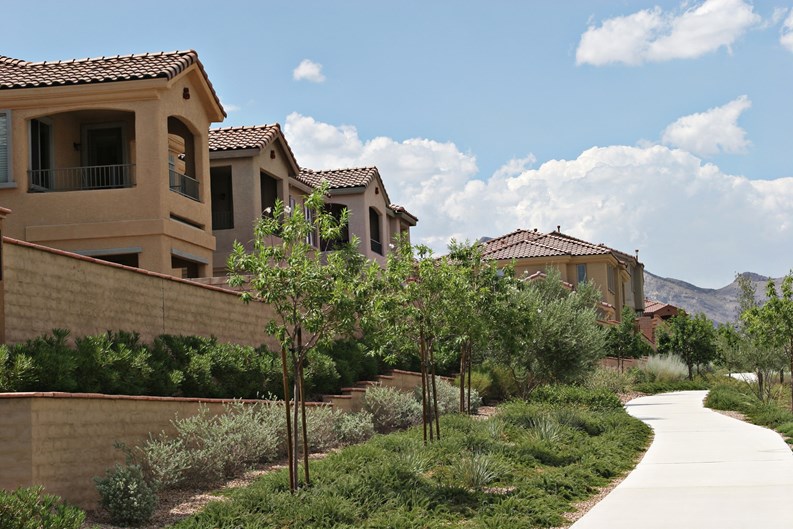Whether it’s a balcony, terrace, patio, or roof deck, outdoor space is many an apartment owner’s dream. Desirable—and valuable—as they are, these spaces do present specific maintenance considerations for individual owners, co-op corporations, and condo associations, however. Oftentimes, these considerations are complicated by the fact that without specific knowledge of engineering and construction, the signs of potential problems in these spaces are too easily missed.
The Main Culprit
Perhaps unsurprisingly, when structural issues afflict outdoor spaces in modern buildings, the main culprit is water—and culprit 1A is water mixed with salt. Water causes rust and salt can accelerate the process. Whether in a cold or warm climate, these two basic building blocks of life can combine to erode structures. Alan Gaynor, founding principal at Boddewyn Gaynor Architects DPC in New York City, explains: “If water gets between concrete and brick and the structure is not flashed properly, it will rust out the reinforcement bars,” which are a critical component in modern construction.
Michele Boddewyn, president of Boddewyn Gaynor Architects, adds that “snow melts, and the salt greatly reduces the freezing temperature of water, so the water can do additional damage.” Gaynor adds that salt can be the biggest issue, because it’s corrosive enough to rot steel over time. “Amenities like balconies and terraces are vulnerable to weather and wind,” he says. “They don’t get used continually, so the problem can go unnoticed for a long time.”
The unique climate extremes common in Nevada add another dimension to what weather can do to decks, balconies, terraces, and patios. “Our climate has a dramatic effect,” says contractor Greg Munoz, owner of Deck Systems in Las Vegas. “We use a specific product to deal with the extremes. Most of the decks and balconies in our area—around 80 percent—are wood. Any time you have the expansion of wood or concrete due to hot and cold conditions, it tends to dry out the materials. UV rays are also a problem. When we have rain, it can be very severe, three inches in a day or two. There’s also dust. All these things affect decks, balconies, etc. We use a cementitious product, a polymerized cement to protect the wood or concrete. It makes materials non-porous, so the water can’t get in. We coat the decks with it. It also contains a UV stabilizer. Typically wood decks out here last three to five years, but with this coating they last much longer.”
Man-Made Problems
In addition to weather, spaces such as balconies, terraces, and roof decks can be damaged by the very people lucky enough to have them. The biggest and most dangerous of these man-made issues is overloading. Too much weight can, in the extreme, cause the balcony or terrace to collapse. “Balconies are designed for moderate to average loads,” says Boddewyn. “We are familiar with a situation where a contractor was storing building materials on a balcony. Their weight greatly exceeded what was intended for the balcony and began to cause a problem.” The contractor had to remove the items immediately, and fortunately no one was injured—or worse.
Marcy Kravit, managing director with AKAM On-Site, a property management firm in southeast Florida, describes an incident in which a condominium owner placed a hot tub on a balcony. Nice idea, but once the tub was filled with hundreds of gallons of water, it was far too heavy for the structure. The attorney for the association notified the resident in writing that the hot tub had to be removed immediately.
In terms of terraces, weight issues can be a subtler threat. The downstairs neighbor may in fact be the ‘canary in the coal mine’ who raises the alarm when something is amiss overhead. Damage caused by water infiltrating the floor of a terrace, or by excessive weight, may be more noticeable on the ceiling of a downstairs neighbor than on the terrace itself. With roof decks, the question may be even more complicated and may depend on whether the deck was part of the original design of the property or added later.
“The big difference between a building designed with the intention of including a roof deck, or a building where one is added later is that most roofs are designed for a certain amount of snow load based on building code relative to your climate zone,” says Boddewyn. “The first big question is to determine what the original weight capacity for the roof was, because it’s very easy to exceed the load capacity when you’re adding pavers, planters with large bushes or trees, furniture, and people. Are you working within the building’s physical capacity?”
Other Maintenance Issues
“A number of challenges arise in the management of amenities,” says Carl Borenstein, President of Veritas Property Management in New York City. “A pool, for example, requires extra payroll. It requires supplies, and you are required to have Board of Health inspections. You’re also required to deal with people—kids who are lifeguards, for example. You have to make sure they are actually doing their job. There is also the aspect of upkeep. If the item is a structure, it requires physical plant inspections, and sometimes repairs of problems like leaks. When I say ‘leaks,’ it’s not just the repair; sometimes water is lost, yet you are still paying for that lost water through your water bill. If an amenity is a structural element, that has to be maintained. I’ve heard of buildings with swimming pools that have collapsed because they weren’t maintained properly.”
“Many community managers who run condominiums have never run an indoor pool, or have not had to manage a fitness facility,” adds Edward Corless, President of Associa Carolinas based in Charlotte, North Carolina. “There are different codes and standards that go with that, and there are health and building codes. Also, you have the challenge of organizing people to use the amenities and creating the social networks that will allow community functions to occur.”
Monitoring for Safety
To maintain the integrity of exterior spaces, those spaces should be inspected on a regular basis. Munoz recommends that inspections be done every three years, and always by professionals. Even professional community managers often don’t have the technical knowledge to recognize potential problems—and that can be costly in the long run.
Gaynor agrees. “Inspections should be done by professionals—untrained staff members might not know what to look for,” he says. “Most buildings have a building architect, and they should do the inspection. If not, hire a building envelope consultant to do the job.” Building envelope consultants are engineers who are experts in all the elements of a building shell that keep the structure dry, heated or cooled, and maintain and facilitate a building’s climate control.
“We also do periodic inspections for rules compliance for storage issues,” Kravit adds. She explains that most associations in Florida have very strict, specific rules about what can and can’t be placed on balconies and terraces, particularly during hurricane season. Generally, when a hurricane is predicted, only patio furniture can be left on balconies, terraces, decks, and patios; everything else must be brought inside, and hurricane shutters drawn down. Anything and everything can turn into a projectile during a hurricane, so securing outdoor spaces is crucial for protecting both property and physical safety.
Because of the fire risk, most associations—in Florida and everywhere else—prohibit keeping grills of any kind on balconies, terraces, roof decks, and even some patios. Kravit explains that some associations will permit grills on ground-level patios, but they must be kept at a specified distance from the building, be supervised whenever they’re in use, and coals and other fuel must be disposed of safely.
Mold
Another problem more common in damp climates, but of concern in any community, is mold. “Many communities have outlawed carpet on balconies because of this issue,” says Kravit. Even in drier climates, condensation can accumulate under such coverings and create a mold problem over time. “Some communities no longer even permit tile,” Kravit adds, “which can hold water in and damage concrete.” AKAM manages a building in Hallandale Beach, Florida, that recently undertook a large project to repair concrete work, including balconies. The board now prohibits any type of floor covering on the refurbished balconies to prevent future damage. Instead, Kravit says, they are using a decorative seal coating on the concrete to repel moisture and give the balconies a consistent look.
Cooler Climes
In terms of correcting weather damage in colder climates, Gaynor recommends that rather than just patching cracked concrete, a sealant should be used to prevent future water-based damage. “When a building is constructed,” he says, “balconies should have a slight slope to them to keep the water flowing off them. That keeps the water away from the joint between the building and the balcony structure. That’s the spot that fails. Proper waterproofing is critical. You can’t give the water a point of entry.”
Terraces are similar. They are not flat, but rather have slight grade variations to enable water drainage. Even in a very well-managed building or HOA, problems may arise simply from age and the useful lifespan of its physical components. Exterior elements may simply need maintenance, or even occasional replacement as they wear out. The concept is no different than the re-pointing required in brick facades every 50 or 100 years.
When it comes to roof decks—particularly those added later and not built as part of the original building plan—specific attention should be paid during their installation, and on an ongoing basis to prevent (or at least minimize) damage to the roof membrane beneath the deck surface. These asphalt ‘roll-out’ roofs typical of many multifamily buildings are not intended for regular walking, let alone the heavy wear-and-tear a roof deck typically gets from foot traffic, furniture, landscaping elements, and the like. A heel from a shoe can do serious damage to a roof membrane, which in turn can lead to water infiltration and the host of problems that opens up. So the integrity of the roof must be inspected and maintained regularly.
Responsibility for the upkeep of exterior spaces may also depend on your governing documents. Are these spaces under the purview of the unit owner, the association or corporation, or both? They may be a limited common element, in which case both the unit owner and association are involved—though the association would need permission to enter, inspect, and repair such an element inside a private unit. Check your governing documents to determine where your unit—including its exterior spaces—stands on this very important matter.
Catastrophic failures are rare. All told, having outdoor spaces like balconies, terraces, roof decks, and patios is a privilege and a pleasure—as long as those spaces are used properly and maintained with the utmost respect and attention.
A J Sidransky is a staff writer/reporter for CooperatorNews, and a published novelist. He can be reached at alan@yrinc.com.







Leave a Comment